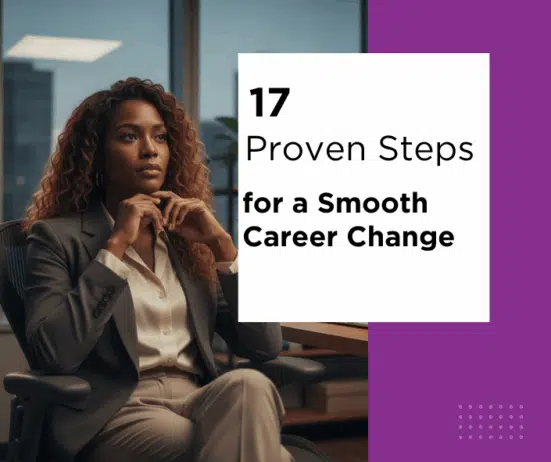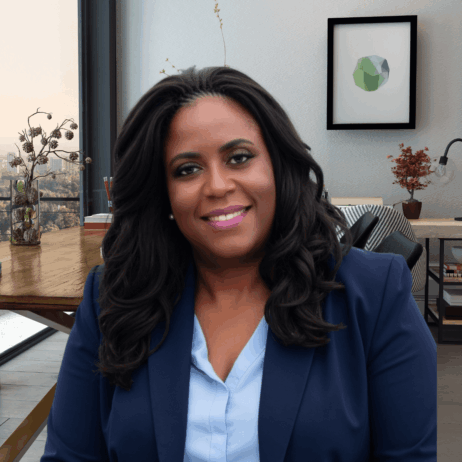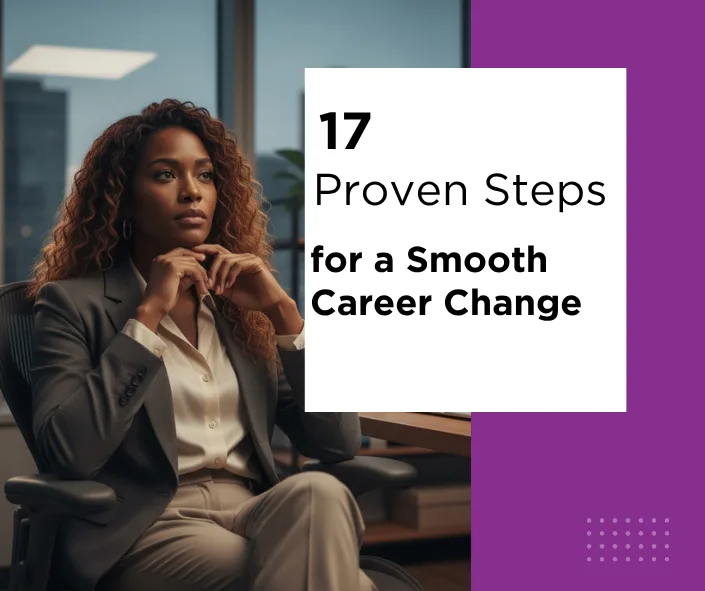October 12, 2025
Career Advancement, Career Change, Career Guidance, Career Pivot, Career Transition, Executive Coaching

Why Changing Careers Is a Smart Move in Today’s World
In today’s fast-changing job market, more people than ever are rethinking their career paths. Whether you feel stuck, unfulfilled, or simply ready for a new challenge, learning how career change can be one of the most empowering decisions of your life. The good news? You’re not alone. Studies show that the average person changes careers at least three times during their lifetime and many do so successfully. I’m an overachiever, I changed career over 10 times🤷🏾♀️
Career change isn’t just about switching jobs; it’s about realigning your life with your passions, skills, and long-term goals. This guide will walk you through 17 proven steps to help you transition confidently and strategically, no matter your age, background, or industry.
Understanding Your Motivation for Career Change
Before jumping into job listings, take a step back and identify why you want a career change. Understanding your motivations ensures your next move aligns with your values and long-term happiness.
Recognizing Signs You’re Ready for a Career Change
- You constantly feel drained or unmotivated at work.
- You no longer find your job meaningful or aligned with your goals.
- You’re drawn to a completely different field or passion project.
- You crave growth, creativity, or flexibility your current job doesn’t offer.
Emotional and Financial Reasons Behind a Career Change
Some people pursue new careers for emotional satisfaction, while others seek better financial stability. For instance, someone in a low-paying but fulfilling job may look to balance purpose with income, while another may prioritize a flexible schedule to support family needs. Clarifying these motives helps you make practical, informed choices.
Assessing Your Current Skills and Interests
Before you decide on a career change, evaluate the skills and interests you already possess.
How to Identify Transferable Skills
Transferable skills are abilities you can use in multiple fields, like leadership, communication, critical thinking, or project management. Make a list of your top achievements and identify which skills helped you reach them. Then, matching these skills to your desired industry sets you up for a smooth career change.
Tools and Methods for Self-Assessment
Use platforms like MyNextMove, O*NET Online, or CareerExplorer to identify careers that align with your personality and strengths. Personality tests such as the MBTI or ProfileXT can also provide clarity for the career change.
Exploring New Career Paths and Opportunities
When exploring how to change career paths, research is your best friend.
Researching Growing Industries and Job Trends
Look into industries with rising demand such as:
- Technology (AI, cybersecurity, data analysis)
- Healthcare (telemedicine, nursing, therapy)
- Sustainability (renewable energy, green construction)
- Digital marketing and e-commerce
These sectors offer room for growth and learning.
Networking with Professionals in Target Fields
Join LinkedIn groups, attend webinars, and reach out for informational interviews. Most professionals are open to sharing insights about their fields, and these conversations can lead to valuable connections or mentorship.
Building the Right Skill Set for Your New Career Change
Once you’ve chosen a direction, it’s time to develop the skills that will help you thrive.
Upskilling Through Online Courses and Certifications
Websites like Coursera, Udemy, LinkedIn Learning, and edX offer affordable courses to help you master new skills. Many even provide certificates that enhance your resume.
Gaining Strategic Experience Through Advisory, Project, or Board Roles
At the executive level, “gaining experience” isn’t about starting from scratch. It’s about positioning yourself where your expertise adds value while expanding your perspective. Consider pursuing strategic opportunities such as serving on advisory boards, leading cross-functional projects, consulting on initiatives in your target industry, or partnering with mission-driven organizations. These experiences not only strengthen your credibility in a new space but also demonstrate agility, influence, and the ability to lead beyond traditional boundaries.
Creating a Career Change Action Plan
A structured plan helps turn your career dreams into reality.
Setting SMART Goals for Your Career Transition
At the executive level, career transitions require precision and purpose. Setting SMART goals, Specific, Measurable, Achievable, Relevant, and Time-bound, ensures your next move aligns with both your professional legacy and future aspirations.
For instance: “Expand my leadership impact by completing an executive certification in strategic innovation within four months and securing a board advisory or C-suite role aligned with my expertise by the end of Q2.”
This approach allows you to translate your vision into actionable milestones while maintaining momentum and accountability throughout your transition journey.
Managing Timelines and Milestones Effectively
Break your journey into short-term and long-term goals. Track your progress weekly and adjust as needed.
Updating Your Resume and LinkedIn Profile
Your resume and online presence should reflect your new professional identity.
Writing a Career Change Resume That Stands Out
- Highlight transferable skills and relevant achievements.
- Use a functional resume format emphasizing skills over job history.
- Include keywords from your target industry to pass ATS scans.
Optimizing LinkedIn to Reflect Your Evolved Career Vision
Your LinkedIn profile should tell the story of who you’ve become and where you’re headed next. Update your headline to reflect not just your title, but your leadership identity and purpose. For example:
C-Suite Leader Championing Strategic Growth | Transitioning to Impact-Driven Consulting | Empowering Women in Leadership.
Use your profile as a platform to own your narrative. Share articles, comment on industry trends, and engage in conversations that align with your future direction. Authentic engagement signals thought leadership and positions you as a woman who leads with clarity, courage, and conviction, not just credentials.
How to Handle Interviews When Changing Careers
Explaining Career Change Confidently
1️⃣ Corporate Executive → Entrepreneur
When explaining your transition from corporate leadership to entrepreneurship, highlight your strategic insight and drive for innovation. Frame it as a purposeful expansion of influence, not a departure.
“After years of leading high-performing teams in corporate settings, I identified an opportunity to apply my strategic and operational expertise to build something of my own. Launching my business allows me to combine my leadership experience with a deeper sense of purpose and ownership.”
2️⃣ Corporate Executive → Nonprofit or Mission-Driven Leadership
For executives shifting toward the nonprofit or social impact space, the key is to convey values-driven leadership and alignment with a greater mission.
“Having achieved success in corporate leadership, I wanted to channel my experience toward initiatives that align more closely with my values. My background in strategy and stakeholder management translates directly into driving measurable impact within the nonprofit sector.”
3️⃣ Corporate Executive → Independent Consultant / Board Advisor
For women transitioning to consulting or board advisory roles, focus on thought leadership and the desire to influence multiple organizations through strategic insight.
“After leading complex organizations through growth and transformation, I recognized that my greatest strength lies in helping others do the same. Transitioning into consulting allows me to leverage my executive experience to guide diverse organizations toward innovation and sustainable success.”
4️⃣ Corporate Executive → Thought Leadership / Speaking
When stepping into thought leadership, position your transition as a strategic evolution from leading organizations to shaping ideas and future leaders. Emphasize the continuity of influence, from managing change to inspiring it.
“After decades of leading at the executive level, I felt compelled to broaden my impact by sharing the lessons, frameworks, and leadership principles that shaped my success. Transitioning into teaching and thought leadership allows me to mentor the next generation of leaders while contributing to the dialogue on organizational innovation and inclusive growth.”
Highlighting Transferable Skills During Interviews
Demonstrate how your past experience adds value to the new role. Use the STAR method (Situation, Task, Action, Result) to answer behavioral questions effectively.
Overcoming Challenges During a Career Change
Switching careers can be exciting, but it often comes with a mix of fear, uncertainty, and self-doubt. The key to success lies in preparation and mindset.
Dealing with Self-Doubt and Imposter Syndrome
It’s natural to feel like a beginner again, especially if you’re entering a completely new field. To overcome imposter syndrome:
- Focus on your progress rather than perfection.
- Celebrate small wins, like completing a course, networking with a mentor, or getting your first interview.
Confidence grows from consistent action. Each new skill mastered or challenge faced adds to your sense of competence.
Managing Financial and Emotional Stress
Changing careers may temporarily impact your income or lifestyle. Here’s how to manage it smartly:
- When possible build a financial buffer (3-6 months of living expenses).
- Start a side hustle or freelance gig in your new field before quitting your current job.
- Surround yourself with a supportive community, family, friends, or online groups of fellow career changers.
Emotional support is just as crucial as financial planning. Talking to an executive coach and therapist can also help you stay focused and positive.

Real-Life Success Stories of Executive Career Changers
In today’s dynamic professional landscape, the most successful leaders are those who know when to evolve. For many executive women, a career transition isn’t a step back, it’s a strategic leap toward greater alignment, influence, and impact. These transitions are less about leaving something behind and more about amplifying one’s purpose in a new context.
The following stories of three remarkable clients. All who navigated transformative shifts exemplify how clarity, courage, and strategic vision can redefine a career at the highest levels. Their journeys demonstrate that leadership evolution isn’t about reinvention for reinvention’s sake; it’s about leading yourself first so you can lead others more powerfully in the next chapter.
Nothing illustrates the power of reinvention more than the stories of women who’ve navigated bold transitions with clarity and courage. Each of these leaders redefined success on her own terms, proving that changing careers at an executive level isn’t about starting over. It’s about evolving strategically.
Client I.S. – From Nonprofit Leader to Corporate Marketing Executive
After years of impact-driven work in the nonprofit sector, I.S. recognized that her expertise in storytelling, stakeholder engagement, and strategic partnerships could create significant value in the corporate world. By repositioning her experience through a results-oriented lens and refining her personal brand, she transitioned seamlessly into a senior corporate marketing role, where her purpose-driven perspective continues to elevate brand strategy and authenticity.
Client L.S. – From Tech Professional to Entrepreneur
L.S. built a successful career in the technology industry but felt a growing desire to channel her innovation and leadership into something more personal and purposeful. Through strategic planning, executive coaching, and market analysis, she launched her own human-focused consultancy. Bridging the gap between innovation and business strategy. Today, she leads her company with the same analytical precision and vision that once made her a standout in the corporate tech world.
Client L.M. – From Senior Leader to Vice President in Healthcare
With years of operational excellence and people leadership behind her, L.M. set her sights on executive advancement within the healthcare sector. By honing her executive presence, clarifying her leadership narrative, and leveraging measurable achievements, she successfully advanced to a Vice President role. Her transition reflects the power of intentional career design, where expertise, visibility, and confidence intersect to open new levels of influence.
These stories highlight a universal truth: successful career change at the executive level isn’t about abandoning past experience. It’s about leveraging it differently. Each of these women transformed her trajectory by combining strategic clarity with the courage to evolve.
These stories prove that your background doesn’t define your future…
…your determination does.
Key Mistakes to Avoid When Changing Careers
Many career changers stumble not because of lack of effort, but due to avoidable missteps. Here are a few to watch out for:
| Mistake | Why It’s Harmful | Better Approach |
| Rushing into a new field without research | Leads to regret and wasted effort | Research industry trends and talk to professionals first |
| Ignoring transferable skills | Undermines your value | Highlight skills that bridge both careers |
| Neglecting personal branding | Weakens credibility | Optimize LinkedIn, portfolio, and resume |
| Expecting instant results | Causes frustration | Set realistic milestones and stay patient |
Avoiding these pitfalls helps ensure a smoother transition and long-term satisfaction.
Resources and Tools for Career Changers
Here are some highly recommended tools to make your journey easier:
- Skill Development: Coursera, Udemy, edX, LinkedIn Learning
- Career Assessments: Myers-Briggs (MBTI), ProfileXT, 16Personalities, O*NET Online
- Job Search Platforms: Indeed, Glassdoor, Remote OK, FlexJobs
- Networking: Meetup, Eventbrite Webinars, VIP Collaborative Network for Black Women LinkedIn Group
Each of these platforms can guide you from learning new skills to landing your dream role.
Career Change FAQs for Executive Women
How do I know when it’s the right time to change careers?
You’ll feel the misalignment first—low energy, low meaning, high curiosity elsewhere. When your dissatisfaction outweighs the fear of change, it’s time to explore with intention.
Can I really change careers after 40 or 50 and still advance?
Yes. Your pattern recognition, influence, and network are assets. Anchor your pivot in measurable wins and map them to the new domain’s priorities.
What if I don’t have direct experience in the new field?
Lead with transferable value—strategy, stakeholder management, P&L, transformation—then layer targeted credentials and high-visibility projects or advisory work.
How long does an executive-level career pivot typically take?
Plan on 6–18 months. Close skill gaps, test assumptions, and set quarterly milestones across learning, networking, and targeted outreach.
Should I quit before I’m ready to pivot?
Usually no. Maintain your role while you build momentum via consulting pilots, board/advisory seats, or cross-functional projects.
How do I explain my pivot in interviews without losing credibility?
Position it as intentional evolution. Connect past impact to future value and use STAR stories that mirror the new role’s KPIs.
How can I gain relevant experience without taking a step back?
Pursue strategic experience: advisory boards, outcome-based consulting, executive fellowships, or mission-driven projects with clear metrics.
What are the most common mistakes to avoid?
Leaping without research, underplaying transferable skills, weak personal branding, and expecting overnight results. Pilot first, then commit.
How do I stay motivated during a long transition?
Win the week: one skill action, one relationship action, one credibility action. Track progress visibly and celebrate momentum.
Where should executive women start if they want guidance now?
Begin with a clarity audit and a 90-day plan. If you’re ready to stop playing small, join the 🌟 VISIBLE Executive Career Pivot Group Program™—an 8-week experience to make your next move undeniable. Only 10 seats available.
Your Future Awaits. Lead Your Next Chapter with Confidence
Stepping into a new chapter of your career isn’t about starting over, it’s about stepping into your full potential with clarity, purpose, and courage. Every intentional move, from redefining your value to building new capabilities, brings you closer to a career and life that reflect who you truly are at this stage of leadership.
There will never be a “perfect moment” to pivot. The right time is the one you claim for yourself. Trust your experience, honor your evolution, and move forward knowing that reinvention isn’t a risk. It’s a strategy for growth.
If you’re ready to stop playing small and start leading your next chapter with clarity and confidence, join the 🌟 VISIBLE Executive Career Pivot Group Program™. An 8-week experience designed to make your next move undeniable. Only 10 seats available.
Your next level isn’t waiting for permission. It’s waiting for you. ✨Complete the VISIBLE Executive Career Pivot Group™ Program interest form today.

I know what it feels like to stumble through a career transition. I flubbed my first move from the military so badly it took me over a decade to rebuild my confidence. That experience fuels my mission today.
I’m Dr. Twanna, Certified Executive Coach and ICF PCC who helps Black women executives secure bigger bonuses, increase visibility, and create the space to actually enjoy life. I understand the weight of imposter syndrome and the pressure to constantly prove yourself at the top. My coaching equips leaders with the tools, strategies, and confidence to navigate career challenges with clarity and authority.
✨ Ready to shift from overworked to unstoppable? Let’s talk.

+ show Comments
- Hide Comments
add a comment